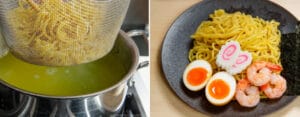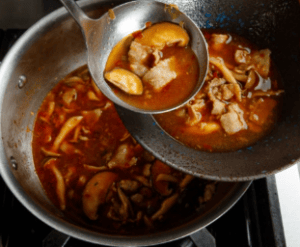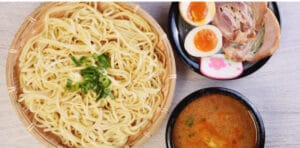Learn to craft Japanese Dipping Noodles with our step-by-step Tsujita Tsukemen recipe for a rich, flavorful dipping ramen experience.
One ramen style I’m particularly keen on recreating is tsukemen, a type of dipping noodle where thick, chewy noodles are served separately from an intensely savory broth that you dip them into before eating. The most famous ramen noodle is from Tsujita in Los Angeles. Their tonkotsu broth is cooked for 60 hours before being finished with seafood, creating an insanely rich, umami-packed base for the noodles.
I love the interactive nature of tsukemen ramen, almost like you’re assembling each perfect bite yourself. The chilled noodles soaked in that hot, lip-smacking broth, then topped with a marinated egg, tender chashu pork, and fresh scallions – it’s a flavor bomb in the best possible way.
My kids are ramen fanatics too, and I know they’d get a huge kick out of dunking their own noodles and customizing each bowl. Plus, tsukemen is perfect for summer when you want something cooling yet satisfying. I’m fired up to try making Tsujita’s famous tsukemen at home. I’ll be using my smoker to make luscious pork belly chashu and my pickling skills for the marinated eggs. Though I doubt my first attempt will live up to the 60-hour tonkotsu broth, that will give me something to strive for. I can’t wait to master this dish and share it with my family and customers!
What is the difference between Tsujita Tsukemen and regular tsukemen?
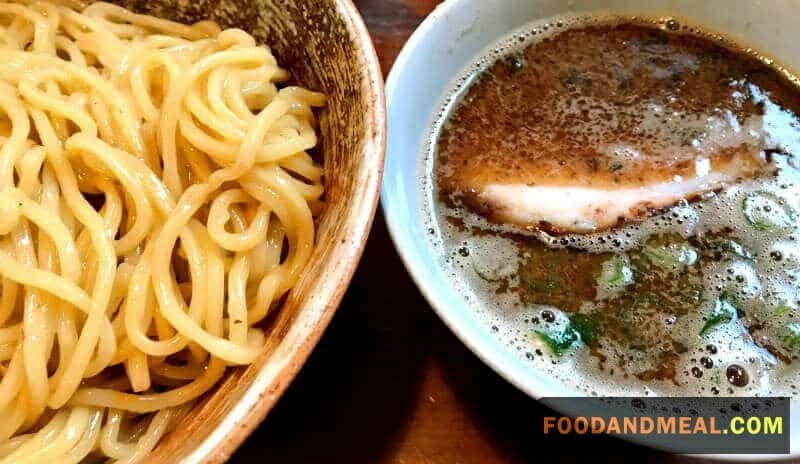
The primary differences between Tsujita Tsukemen and other variations of Tsukemen lie in the specific qualities of the broth, the type of noodles used, and the overall preparation and presentation that are unique to the Tsujita LA restaurant.
- Broth: Tsujita’s broth is known for its richness and complexity. It is typically made from a blend of pork bones, chicken, dried fish, and seaweed, simmered for many hours. The resulting broth is concentrated and robust, often described as having a velvety texture that clings to the noodles. In contrast, other Tsukemen broths may be lighter and less complex, with variations depending on the recipe or regional preferences.
- Noodles: Tsujita LA serves thicker, chewier noodles that are specially made to complement their dense broth. These noodles are designed to not only stand up to the thick broth but also to provide a satisfying texture when bitten into. Other Ramen noodles establishments might use noodles that vary in thickness and chewiness, which can significantly alter the dining experience.
- Toppings: While toppings can vary widely across different Tsukemen recipes, Tsujita is known for its particular selection and preparation of toppings such as chashu, marinated soft-boiled eggs, bamboo shoots, green onions, and nori. The quality and execution of these toppings contribute to the overall flavor profile and authenticity of the dish.
- Presentation: Tsujita LA places a strong emphasis on the presentation of their Tsukemen, with careful arrangement of noodles, toppings, and broth to create an appetizing and authentic experience. Other restaurants may have a different approach to presentation, which can affect the diner’s perception and enjoyment of the meal.
In summary, while the basic concept of Tsukemen remains consistent—cold noodles served with a separate hot broth for dipping—the Tsujita Tsukemen recipe stands out due to its richly flavored broth, distinctive noodles, carefully curated toppings, and meticulous presentation. These elements combine to create a Tsukemen experience that is associated with the Tsujita LA brand and is sought after by enthusiasts of the dish.
Tsujita Tsukemen recipes
Tsukemen is a Japanese ramen dish, which consists of noodles dipped in a flavorful broth. It was invented by restaurateur Kazuo Yamagishi in 1961 and quickly became popular in Tokyo and throughout Japan. There are several different ways to make Tsukemen at home, but the following tips will make the experience even better. Whether you’re looking for a fast and delicious meal, or something that is a little more elaborate, Tsukemen is a great way to get a taste of the country’s cuisine.
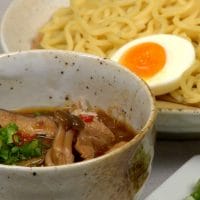
Tsukemen ( Dipping Noodles )
Equipment
Ingredients
- 2 pounds noodles fresh, such as Takasuimen
- 6 cups Tonkotsu Creamy Soup
- ½ cup Shoyu Tare
- 8 to 16 slices Pork Chashu
- 4 Ajitama halved
- 16 to 20 pieces Menma
- Negi
Instructions
- Bring a large pot of water to a boil over medium-high heat. Cook the noodles. Tsukemen is better with thick noodles, and noodles that are around 4 mm thick will cook in around 8 minutes.

- Strain the noodles and run under cool water until the noodles are at room temperature.

- Put the soup and tare in a medium saucepan. Mix and bring to a simmer over low heat. Ladle it into small soup bowls.

- Serve the noodles on large plates, topped with 2 to 4 slices of chashu, 1 egg, 4 or 5 pieces of menma, and a sprinkle of negi.

Video
Notes
Either way, take care slurping the thick noodles—they tend to splatter a bit more than normal ramen. (Bonus tip: Don’t wear a white shirt when eating ramen!)
Nutrition
© Food And Meal
This website provides approximate nutrition information for convenience and as a courtesy only. Nutrition data is gathered primarily from the Spoonacular Database, whenever available, or otherwise other online calculators.
How to make Tsujita la artisan noodle
The process begins with making the broth, which is typically a concentrated, savory soup that can include ingredients like pork bones, chicken, dried fish, and seaweed, simmered for several hours to extract deep flavors. The broth is often seasoned with soy sauce, mirin, sugar, and other seasonings to achieve a balance of salty, sweet, and umami tastes.
Next, the noodles are prepared. Tsukemen noodles are usually thicker than those used in traditional ramen and are boiled until they reach an al dente texture. After boiling, they are rinsed in cold water to stop the cooking process and to give them a firm texture that holds up well to dipping.
Toppings for Tsukemen can vary but often include slices of chashu (braised pork belly), marinated soft-boiled eggs, bamboo shoots, green onions, and nori (dried seaweed). These are prepared separately and arranged for serving alongside the noodles and broth.
To serve, the noodles are placed on a plate or in a bowl, the hot broth is served in a separate bowl, and the toppings are added either on top of the noodles or on the side. The diner then dips the noodles into the broth with each bite, allowing them to enjoy the full flavor of the Tsukemen experience.
While this overview provides a general idea of how to make Tsukemen, the Tsujita Tsukemen recipe would include their unique blend of ingredients and techniques that contribute to the distinctive taste and texture of their dish.
Pressure Cooker Tsukemen ramen
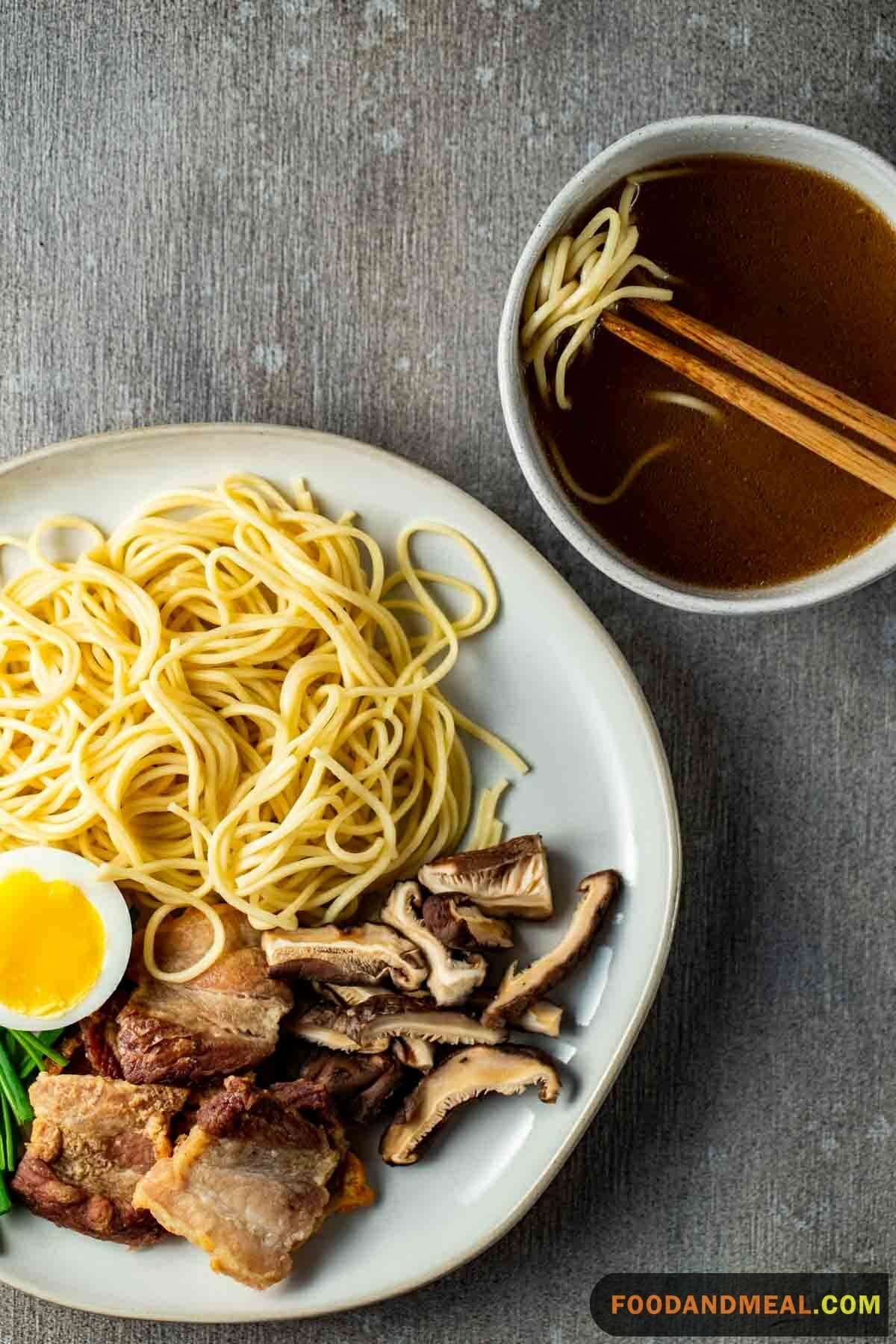
Ingredients:
- 200g dried ramen noodles
- 1 lb pork or chicken bones
- 2 boiled eggs, halved
- 5 cups water
- 1 onion, quartered
- 3 cloves of garlic, smashed
- 1 tablespoon soy sauce
- 1 tablespoon mirin
- Green onions and nori, for garnish
Instructions:
- Broth Creation: Place your bones, whether pork or chicken, into the pressure cooker. These will form the base of your symphony, the initial strokes of a masterpiece of flavors.
- Incorporate Aromatics: Add the onions and garlic. Each inclusion is like a note in a musical masterpiece, integral and profound, contributing to the silent melody that will unfold.
- Pour in the Liquid Gold: Introduce water, soy sauce, and mirin. Every drop is akin to a brushstroke, coloring the canvas of your creation, infusing soul into matter.
- The Silent Cook: Secure the lid and set your pressure cooker to high for 40 minutes. In the quietude that follows, magic unfolds; flavors meld, and aromas rise, each mingling in a silent dance that defies expression.
- Unveil the Essence: Release the pressure and strain the broth, capturing the liquid essence that’s rich with the silent narratives of every ingredient’s journey.
- Noodle Artistry: In a separate pot, immerse the ramen noodles in boiling water, attending to them until they reflect perfection – a tender yet firm embodiment of artistry.
- Assemble the Masterpiece: Place the noodles in a serving bowl with the rich, aromatic broth whispering its silent tales alongside. Adorn with boiled eggs, a sprinkle of green onions, and a sheet of nori, each an intimate expression, a silent verse in this poetic narrative.
How to eat Tsujita tsukemen
Eating tsukemen at Tsujita LA is an experience not to be missed for any ramen lover. As you walk into the minimalist restaurant, the anticipation builds as you put your name on the waitlist, knowing that you are about to enjoy one of LA’s most sought-after bowls of noodles.
When you are finally seated and receive that first steaming bowl of perfectly chewy noodles and intensely flavored umami broth, excitement wells up. I eagerly grab my chopsticks, ready to dive in. The key with tsukemen is to first taste the noodles plain to appreciate their texture before dipping them into the rich broth. That first clean bite fills me with joy and whets my appetite for more.
As instructed by my server, I dip about a third of the noodles into the broth, letting them soak up the flavors before slurping them with delight. The saba flakes in the broth provide a delightful burst of flavor. I add a squeeze of lime as recommended, and the acidity balances beautifully with the broth’s richness. By now, I’m in ramen heaven!
I continue working my way through the noodles, pacing myself to savor the experience. About two-thirds of the way through, I add Tsujita’s five-spice pepper blend to amp up the heat and savoriness even more. The final bites of noodle leave me wishing I had more, but also perfectly satisfied from an incredible meal. As I finish the last drop of broth, I’m already planning my next visit to Tsujita LA for another round of their unbelievable tsukemen ramen. This is an LA ramen experience not to miss!
Tips about Tsujita Tsukemen recipe

Cooking Tips about dipping ramen noodles
- Balance of Flavors: In the dance of ingredients, balance is key. Pay attention to the silent song of umami, sweetness, and saltiness. Each note should emerge, not overpowering, but in harmonious unison, echoing the intricate dance of the cosmos.
- Quality of Ingredients: Choose ingredients that speak to the soul. Each element, from the bones for the broth to the noodles, is a silent storyteller, narrating untold tales of lands, seasons, and elements.
- Common Mistakes: Avoid overcrowding the pressure cooker; allow space for the silent dance of steam and pressures. And resist the temptation to rush. In the quietude of patient cooking, flavors and aromas weave intricate narratives, echoing the soul’s silent songs.
Serving Suggestions

The rich, savory tsukemen broth would pair deliciously with grilled or pan-seared proteins like fish, shrimp, chicken, or steak. I’d suggest serving it alongside lighter vegetable sides like leafy green salads or simply prepared roasted vegetables to balance the intensity of the broth.
Some specific serving ideas:
- Grilled teriyaki salmon filets with a side of chilled tsukemen noodles and dipping broth
- Seared shrimp skewers served over a bed of tsukemen ramen noodles and broth
- Thinly sliced flank steak rolled with scallions and dipped in the umami-packed broth
- Roasted chicken thighs glazed with a sweet soy marinade, with tsukemen noodles and broth for dipping
- A simple arugula salad dressed with lemon and olive oil to help cut the richness of the broth
You could also top the tsukemen noodles and broth with traditional Japanese toppings like marinated eggs, pork chashu, menma bamboo shoots, woodear mushrooms, and scallions to create a more complete meal. And for dessert, the sweet richness of Japanese milk bread or melon pan would be perfect!
9 FAQs of Tsujita Tsukemen recipe

- What is tsukemen sauce made of?
- Tsukemen sauce typically includes soy sauce, mirin, sake, sugar, and sometimes dashi or other flavor-enhancing ingredients.
- How do you eat tsukemen at Tsujita?
- At Tsujita, you typically dip the noodles into the concentrated broth before each bite, savoring the rich flavors.
- Why is tsukemen noodles considered better than ramen?
- This Ramen Noodles are often preferred for its concentrated broth and the interactive experience of dipping the noodles. The separation allows for a more controlled flavor balance.
- How do you thicken tsukemen broth?
- To thicken tsukemen broth, you can simmer it longer to reduce the liquid content, or add ingredients like starch or cornstarch for a thicker consistency.
- Can I Use Different Types of Noodles?
- Absolutely. While traditional ramen noodles are often favored, feel free to explore with udon or soba for a unique Tsukemen experience.
- How Long Can I Store Tsukemen Broth?
- The broth can be stored in the refrigerator for up to 5 days. Ensure it’s cooled before storing and gently reheat when ready to serve.
- Can Tsukemen ramen be Made Vegetarian?
- Indeed. Replace the traditional meat-based broth with a rich, umami-infused mushroom and vegetable broth for a delightful vegetarian alternative.
- How Can I Add a Spicy Kick to My Tsukemen ramen?
- Introduce a dash of chili oil or spicy sesame oil to the broth for a spicy twist, adding layers of heat to the flavors.
- Is it Essential to Serve the Broth and Noodles Separately?
- Traditional Tsukemen embraces the art of separation, allowing the diner to explore distinct terrains. However, culinary artistry encourages both tradition and innovation, so feel free to experiment.
Conclution
In conclusion, attempting to recreate Tsujita’s famous tsukemen ramen at home has been an incredibly rewarding challenge. Though my first few tries didn’t quite measure up to the complex 60-hour tonkotsu broth, I learned so much about Japanese cuisine and flavor profiles with each iteration.
After many tweaks and taste tests, I’ve finally developed a rich, umami-packed tsukemen broth and bouncy noodles that my family and I are proud of. Seeing my kids’ faces light up when they dip those noodles into the broth makes all the effort worthwhile. I can’t wait to keep honing my recipe and eventually serve it to customers when tsukemen ramen makes its debut on my barbecue food truck menu!
This Tsujita Tsukemen recipe experience has shown me that with passion, perseverance, and a little creativity, you can create restaurant-quality dishes at home. I’m hooked on Japanese soul food now and can’t wait to try making other ramen styles next. Though I don’t know if anything will ever beat the pride and satisfaction of finally perfecting my take on the legendary Tsujita tsukemen!





